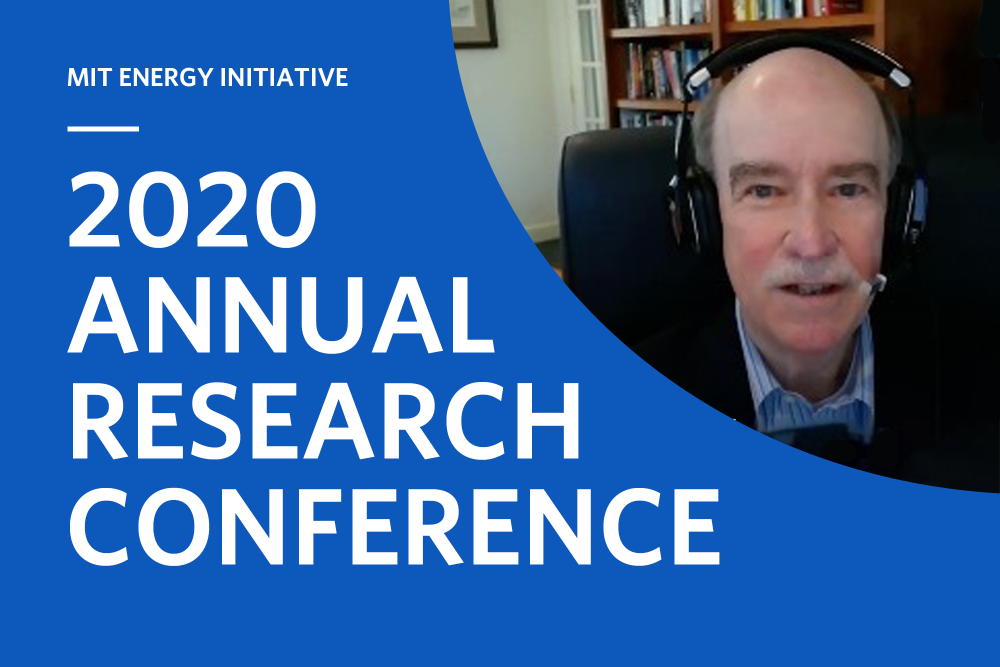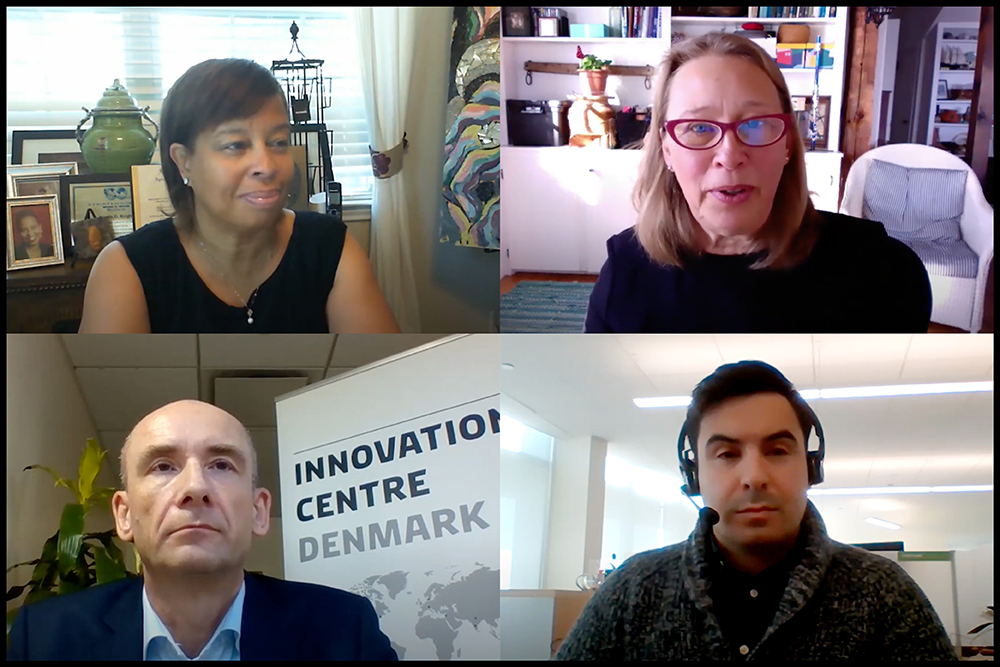
The MIT Energy Initiative (MITEI) recently held its first-ever virtual Annual Research Conference on the theme of “Developing and deploying key decarbonization technologies: Science, students, and scale.” As with other MIT events this year, the conference was held online due to the Covid-19 pandemic.
“This has been a challenging year in many ways for all of us, and I want to take a moment to say that we’re especially glad to have you all with us in this new format,” said MITEI Director Robert Armstrong in his opening remarks. He noted that a benefit of the virtual format is that it enabled MITEI to reach a much larger slice of its membership than its traditional onsite meetings.
Armstrong also addressed the impact of Covid-19 on the clean energy transition, sharing two important lessons from the pandemic that can help us stay on target in addressing climate change: science matters, and we are all interconnected.
“We are a global society. What we do in our own countries impacts the entire world. This also means that we need solutions that can fit in different countries around the world and that we all do our part to reduce emissions,” he said.
MITEI developed this year’s program to reflect its work to address the dual global challenge of bringing energy to people without adequate supply while dramatically reducing greenhouse gas emissions across the energy sector. Over the course of two half-days, speakers explored the use of new emerging digital technologies that will play a key role in energy education and career development, and examined tools and technologies that will be essential to the clean energy transition, including the roles of low-carbon fuels; decarbonizing industry; carbon capture, utilization, and storage; and sustainable mobility.
“Upskilling” the energy workforce
Antje Danielson, MITEI’s director of education, moderated a panel on the role of the university in educating the energy workforce. Panelists included Angela Knight of Chevron; Torben Orla Nielsen of Innovation Centre Denmark Boston; James Rincon of CEO Office; and Sanjay Sarma of MIT.

MITEI Director of Education Antje Danielson (top right) moderates a panel titled, “The role of the university in educating for the energy transition,” with panelists (clockwise) Angela Knight of Chevron, Torben Orla Nielsen of Innovation Centre Denmark Boston, James Rincon of CEO Office, and Sanjay Sarma of MIT (not pictured).
Sarma, the vice president for open learning at MIT, noted that as the number of jobs in the renewable energy industry continues to grow, “upskilling”—providing employees with the resources they need to expand their capabilities and keep pace with rapidly evolving professional fields—is becoming a central aspect of the economy.
“If you look at the renewable energy industry, whether it is in solar photovoltaics, liquid biofuels, or wind, the total number of jobs has increased quite remarkably from 2014 to 2017—we’re talking about 50% over the course of those three years,” said Sarma. This expansion will continue to accelerate as the world moves toward decarbonization and electrification, resulting in a massive, international shortage of skills. Universities have the opportunity to bridge the skills gap and prepare students to enter the energy field though programs such as micro-degrees (e.g., MIT MicroMasters).
Sarma and the other panelists also addressed the rise of the international gig economy, noting that because of widespread unemployment due to the Covid-19 pandemic, there are now more self-employed people in the service industry than ever before. Because society has been pushed increasingly online, those virtual industries are going to dominate the economy in the coming years. Universities and organizations in the energy space have a responsibility to cultivate digital fluency to attract gig workers to the clean energy field and prepare them to make meaningful contributions to a decarbonized future.
Driving sustainability
Ground transportation presents a major barrier to decarbonization. Researchers who are working on projects that are supported through the Mobility Systems Center (MSC), one of MITEI’s newest Low-Carbon Energy Centers, shared their findings on topics ranging from car ownership and use to exploring hydrogen production and infrastructure to deliver low-cost, low-carbon mobility services.
Randall Field, the executive director of the Mobility Systems Center, and Jinhua Zhao, the center’s co-director, introduced the new MIT Mobility Initiative and discussed its collaboration with MITEI on working toward sustainable transportation solutions.
Joanna Moody, the research program manager for the Mobility Systems Center, offered insights from her recently completed survey on car ownership and use in the U.S.
“Significantly greater than half of the value that people place on their private car comes from ownership itself, not the trips they are actually using it for. So it’s hard to think of a package of mobility alternatives that could rival the value and level of convenience that individuals associate with their private vehicles, but I think we can do it,” said Moody. “Our research gives some hints about ‘what are the pathways forward?’”
For example, Moody found that the closer to the urban center a person lives, the more likely they are to get rid of their car in favor of using cleaner mobility alternatives, such as public transit. Therefore, long-term urban and transportation planning matters—bringing convenient alternatives to people, wherever they are, makes a difference in shaping car ownership and use decisions. Moody points out that the responsibility for planning such long-term changes requires collaboration between transportation and urban planners, and she urges better dialogue between the two parties to advance a more holistic mobility system.
“If the status quo continues, we have created an urban environment and transportation system that makes cars the rational choice for most individuals—they provide the most value even though they cost a significant amount of money,” said Moody. “We’d have to change the urban form and transportation system in order to see a change of the car paradigm at the scale or pace needed for meaningful impacts for climate change and other issues.”
Jessika Trancik, an associate professor in the MIT Institute for Data, Systems, and Society, described her newly funded project, in which she will look at how we might advance hydrogen production technology alongside hydrogen-related infrastructure to deliver low-cost mobility services without carbon emissions. “While the prospects for this fuel remain uncertain, I feel that hydrogen deserves a renewed look today for two reasons: opportunity and need,” said Trancik. Falling renewable energy cost and growing markets for solar and wind energy provides opportunities for hydrogen production, specifically in some of the ways the power grid could provide low-cost electricity for hydrogen production from renewable sources. The “need” is for a low-carbon fuel for long-haul and heavy-duty travel.
“What we’re trying to do is advance models that can help nudge these low-carbon technologies forward and help address the climate crisis,” said Trancik. “To do that, we really need to be thinking about the people who will ultimately make the decisions—who’s going to decide whether to adopt these technologies, what are their preferences, desires, and behaviors, and what are the technological limitations?”
Decarbonizing fuels and industry
Desiree Plata, the Gilbert W. Winslow (1937) Career Development Professor in Civil Engineering and associate professor of civil and environmental engineering, highlighted the urgency and difficulty of transitioning today’s systems that require fossil energy, saying, “There’s a challenge on the table to try and meet those needs while minimizing carbon—in other words, moving to low-carbon fuels.”
Plata moderated the low-carbon fuels panel, which included Steven Barrett, a professor of aeronautics and astronautics. Barrett spoke from Seoul, South Korea, where he is a visiting professor in Seoul National University’s mechanical and aerospace engineering departments. He is focused on the challenge of decarbonizing aviation—one of the toughest areas within the transportation sector to decarbonize. He explained that there is no “plan A” in terms of using technology alone to decarbonize the sector; in fact, all viable paths to sustainable aviation lead to fuels.
“We need to reduce emissions as quickly as possible. Even if we can’t get to net-zero carbon emissions tomorrow, we need to reduce emissions as much as possible because the atmosphere accumulates CO2 as a kind of stock—so all emissions reductions, even if they are small, have an impact on long-term temperature changes and sustainability,” said Barrett.
About $2 trillion worth of aircrafts are in use around the world today, and they are projected to fly for 20-30 more years. Because the timescale for decarbonizing aviation is so long, mainly due to the astronomical cost of replacing today’s infrastructure and stock of aircraft with cleaner counterparts, we cannot rely on future aircraft designs alone to help us achieve our emissions goals because they will not be available quickly enough. To achieve urgent emissions reductions in the near-term, Barrett emphasized the need for “drop-in” fuels, which are biofuels that can be interchanged with conventional (dirtier) fuels in our existing aircraft.
Yogesh Surendranath, the Paul M. Cook Career Development Associate Professor of Chemistry, works on the chemistry behind low-carbon fuels, and he is fascinated by what he calls the “multidisciplinary nature of the fuels challenge.” He shared that carbon-based fuels are something society gravitated to because of their liquid form, easy transportability, and high energy density. Much of his research centers around answering the question, “How can we sustainably convert CO2 to liquid fuel to meet energy demands?” He is optimistic about opportunities for the conversion of CO2 using renewable electricity to make drop-in fuel substitutes for sectors like aviation in order to help the world meet its deep decarbonization challenges.
The issues of decarbonizing aviation and industry were echoed in a later panel on carbon capture, utilization, and storage (CCUS), which revealed how CCS is evolving to solve the problem of “hard-to-eliminate” emissions sources. Howard Herzog, a senior research scientist at MITEI, presented new ways that CCS is being implemented, including using steam methane reforming (SMR) with CCS to produce cleaner hydrogen instead of producing hydrogen from SMR alone with natural gas; bioenergy with carbon capture and storage (extracting bioenergy from biomass and capturing and storing the carbon); and direct air capture (capturing CO2 directly from the atmosphere). He analyzed the costs for each of the three CCS technologies and concluded that the feasibility of CCS technology going forward hinges on innovation and policy changes.
“There is room to improve costs for CCS, but it will always be cheaper to emit CO2 into the atmosphere than it is to capture it. Therefore, policy is required in order to make CCS economically viable,” said Herzog.
Betar Gallant’s group examines electrochemical CO2 capture and conversion technologies, and is looking at how electrochemistry can play an expanded role in CCUS, focusing on the “utilization and storage part of the picture.
“We are trying to create an efficient connection between point-of source emissions and safe, stable, permanent storage, and we’re interested in seeing if we can do this in a way that’s faster, energy efficient, and versatile, so that we don’t have to be confined to specific storage sites, but can think about running these processes potentially anywhere,” said Gallant.

On the “Decarbonizing industry” panel, Emre Gençer of MITEI (top center) moderates a discussion on what it will take to reduce emissions in the industrial sector with panelists (clockwise) Bilge Yildiz of MIT, Joe Powell of Shell, Karthish Manthiram of MIT, and Yet-Ming Chiang of MIT.
Cleaning up industry presents another formidable challenge to the energy transition. Joe Powell, a chief scientist of chemical engineering at Shell, and several MIT faculty members, including Karthish Manthiram, the Theodore T. Miller Career Development Chair Assistant Professor of Chemical Engineering, provided overviews of their related research, ranging from decarbonizing chemical manufacturing to cement production and “trash tech” (burning trash as fuel) to ethylene decarbonization.
“If we are serious about decarbonizing chemical manufacturing, we are definitely going to need to find ways to decarbonize the production of ammonia, which has an enormous carbon footprint,” said Manthiram. His group is working to convert nitrogen and water into ammonia as a cleaner alternative to the popular Haber-Bosch process, which uses natural gas as a source of hydrogen, leading to CO2 emissions.
“The chemicals and materials that are used to build the physical world have an enormous energy footprint. In fact, technologies that were first created with the intention of having an impact on renewable energy are going to drive the initial wave of decarbonizing the production of chemicals and materials,” said Manthiram.
Addressing the future energy system
Robert Stoner, the deputy director of science and technology at MITEI, closed out the virtual conference by reflecting on the multidisciplinary character and broad range of skills that MITEI draws upon from across the MIT and its membership in its mission to contribute to a low-carbon future. “The agenda has been a reminder of MITEI’s institutional charge to tackle energy and its environmental implications broadly, and to look for solutions,” he said.
Although virtual, the conference reinforced the urgency of finding and implementing clean energy solutions—however incremental they may seem—in order to meet international climate goals.
“Averting one million tons of CO2 now is worth much more than averting one million tons of CO2 in 2050,” said Steven Barret. “An imperfect solution is worth a lot if done at pace.”